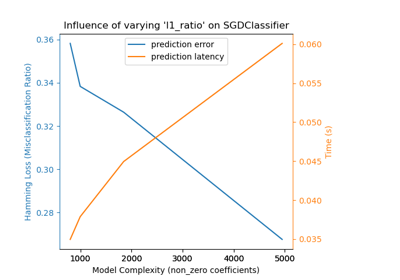hamming_loss#
- sklearn.metrics.hamming_loss(y_true, y_pred, *, sample_weight=None)[source]#
Compute the average Hamming loss.
The Hamming loss is the fraction of labels that are incorrectly predicted.
Read more in the User Guide.
- Parameters:
- y_true1d array-like, or label indicator array / sparse matrix
Ground truth (correct) labels.
- y_pred1d array-like, or label indicator array / sparse matrix
Predicted labels, as returned by a classifier.
- sample_weightarray-like of shape (n_samples,), default=None
Sample weights.
Added in version 0.18.
- Returns:
- lossfloat or int
Return the average Hamming loss between element of
y_trueandy_pred.
See also
accuracy_scoreCompute the accuracy score. By default, the function will return the fraction of correct predictions divided by the total number of predictions.
jaccard_scoreCompute the Jaccard similarity coefficient score.
zero_one_lossCompute the Zero-one classification loss. By default, the function will return the percentage of imperfectly predicted subsets.
Notes
In multiclass classification, the Hamming loss corresponds to the Hamming distance between
y_trueandy_predwhich is equivalent to the subsetzero_one_lossfunction, whennormalizeparameter is set to True.In multilabel classification, the Hamming loss is different from the subset zero-one loss. The zero-one loss considers the entire set of labels for a given sample incorrect if it does not entirely match the true set of labels. Hamming loss is more forgiving in that it penalizes only the individual labels.
The Hamming loss is upperbounded by the subset zero-one loss, when
normalizeparameter is set to True. It is always between 0 and 1, lower being better.References
[1]Grigorios Tsoumakas, Ioannis Katakis. Multi-Label Classification: An Overview. International Journal of Data Warehousing & Mining, 3(3), 1-13, July-September 2007.
Examples
>>> from sklearn.metrics import hamming_loss >>> y_pred = [1, 2, 3, 4] >>> y_true = [2, 2, 3, 4] >>> hamming_loss(y_true, y_pred) 0.25
In the multilabel case with binary label indicators:
>>> import numpy as np >>> hamming_loss(np.array([[0, 1], [1, 1]]), np.zeros((2, 2))) 0.75

